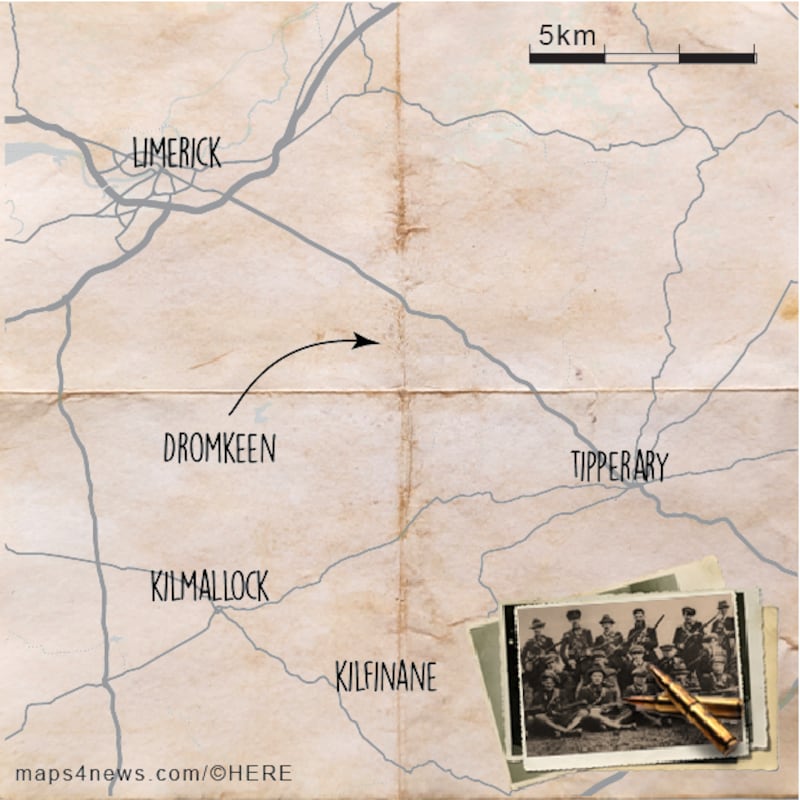County: Limerick
Incident: Shooting of Robert Byrnes
Date: April 6th, 1919
IRA volunteers claimed they were ready to rise up against the British army presence in the city after the Limerick Soviet was declared, but were prevented from doing so by Gen Richard Mulcahy.
The Limerick Soviet occurred after the death of the first IRA volunteer in the War of Independence.
Robert Byrnes, a post office worker from Meelick, Co Limerick, was shot dead on April 6th, 1919, while trying to escape from the Union Workhouse on Shelbourne Road in Limerick, where he was under armed guard.
On April 6th, 1919, a party of IRA volunteers went to rescue him. In the ensuing gun battle, Byrnes was shot and fatally wounded along with RIC man Constable Martin O’Brien, a 35-year-old policeman from Co Tipperary. He died that evening in a safe house.
Byrnes’ death is most famous today for being the catalyst which led to the Limerick Soviet – a two-week general strike in the city against British rule which occurred in late April 1919. The Limerick Soviet was in response to the British authorities that made Limerick a special military area and severely restricted movement in and out of the city.
Mulcahy, the chief of staff of the IRA, arrived in Limerick a short time after the two-week soviet began. According to an account by the 1st Limerick city battalion of the Mid-Limerick Brigade of the IRA, Mulcahy enquired about the “practicability of engaging the British in a big battle . . . companies were mobilised by way of test”.

The battalion account, as contained in the files of the Mid-Limerick Brigade, suggested the men involved responded with alacrity to Mulcahy’s request.
“Never was there such a response because the men felt there was a chance to show what they were made of and all the rifles and equipment necessary would be brought down from Dublin and given to our men to fight with. It was this rumour which was responsible for the unprecedented parade.”
No chance of success
Mulcahy, however, concluded there was no chance of success in a city “with the numbers that could be put into the field, even with outside help”.
The Mid-Limerick Brigade files contain a full account of the death of Byrnes, who was the battalion adjutant in Limerick city.
Their meticulous planning involved building a model of the hospital ward, a replica key and hiring an undertaker to spirit Byrnes out of the building alive on the understanding that the RIC would not stop a hearse. IRA men fanned out across the hospital disguised as visitors.
Their plans went badly awry, however, when they faced unexpected resistance from RIC men guarding Byrnes. “The struggle was fierce and short, the police was overpowered, disarmed, bound hand and foot and gagged, but not before a number of volunteers had received minor bruises and injuries,” according to an account by members of C Company of the Limerick City 2nd battalion.
Limerick was one of the “hottest” counties during the War of Independence and saw two of the biggest ambushes of the war.
At Dromkeen outside Limerick city on February 3rd, 1921, 11 RIC men and Black and Tans were killed in an ambush. The files of the East Limerick Brigade includes the names of 16 men from the brigade who were involved in the ambush, but no description of the action.
They include Maurice Meade, a former British soldier who was captured at the start of the first World War. He was recruited in a prisoner-of-war camp by Roger Casement and saw service with the German army in the war.
Meade claimed later in a statement to the Bureau of Military History that he executed two Black and Tans who had played dead and tried to escape from the ambush.










